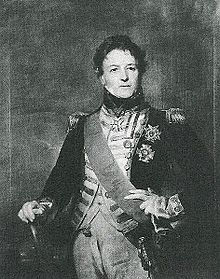Philip Charles Durham
| Sir Philip Durham | |
|---|---|

Portrait as a Vice Admiral (about 1820)
Artist - Sir Henry Raeburn |
|
| Born |
29 July 1763 Largo, Fife, Scotland |
| Died | 2 April 1845 (aged 81) Naples, Italy |
| Place of burial | Largo church, Largo, Fife, Scotland |
| Allegiance |
|
| Service/branch |
|
| Rank | Admiral |
| Commands held |
Leewards Islands Station Portsmouth Command |
| Battles/wars |
American War of Independence French Revolutionary War Napoleonic Wars |
| Awards | Knight Grand Cross of the Order of the Bath |
Admiral Sir Philip Charles Calderwood Henderson Durham, GCB (29 July 1763 – 2 April 1845) was a Royal Navy officer whose service in the American War of Independence, French Revolutionary War and Napoleonic Wars was lengthy, distinguished and at times controversial.
Destined to be one of the luckiest men in the Georgian Navy, Philip Charles Durham was born in Largo, Fife in 1763, the fourth child and third son of James Durham His maternal grandmother was the diarist Margaret Calderwood. He came from a wealthy landed family, and entered the navy aged fourteen in 1777 aboard the ship of the line HMS Trident. His first year at sea became rather difficult when he found himself under a tyrannical and occasionally sadistic commander, who reduced the ship to a state of near mutiny on a couple of occasions. In 1778 Durham procured his discharged and afterwards obtained a position on HMS Edgar in British waters where conditions were far more pleasant and educational. On this ship he saw his first action during the Great Siege of Gibraltar, gaining the attention of Admiral Richard Kempenfelt, with whom he served on HMS Victory and HMS Royal George. Durham was watch officer on 29 August 1782 when, through no fault of his own, the Royal George, which was heeled for repairs, suddenly and catastrophically sank at Spithead. Being on deck, Durham was able to jump overboard and swim to safety, but the Admiral and over 800 persons lost their lives.
Durham was transferred to HMS Union in which he saw further service at the siege of Gibraltar before making a cruise to the West Indies and then another one down the African coast in HMS Raisonnable as a junior lieutenant. With failing health and the end to the war that year however, Durham was temporarily retired from the navy and spent the next two years living in France before returning to the sea. In 1786 he served in HMS Barfleur.
...
Wikipedia
